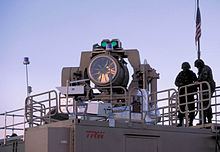Tactical High Energy Laser
The Tactical High Energy Laser , short THEL (English for Tactical High Energy Laser ) was a project for a high-energy laser weapon system, which was to combine components of laser beam technology with sensors and alignment technology to an active defense system against fire by artillery weapons . The development was stopped after ten years - with the official reason that the costs were too high. The shooting rates were also minimal and the devices too large and immobile.
Development history
In the 1990s, the United States and Israel began a joint project called Nautilus to develop a laser to launch enemy missiles. In 1996 a successful test was carried out. Therefore, on 18 July 1996 a Memorandum of Understanding between the Government of the United States and Israel that was signed in what was identified as an objective, a so-called Advanced Concept Technology Demonstrator (ACTD) using a chemically pumped laser ( deuterium - fluoride laser, Engl. deuterium-fluoride chemical laser , DFCL). The US interest was to protect bases and troop concentrations abroad from attacks with artillery weapons. The contract, valued at $ 89 million, was awarded to TRW .
Tests on the White Sands Missile Range in New Mexico were successful. For example, the system destroyed a total of 28 approaching Katyusha missiles in flight in several test runs . On the occasion of further tests during the last few years it was possible to destroy incoming artillery shells. In early May 2004 a larger, high-flying missile was successfully shot down; a kind of goal for which the THEL was not actually designed. On August 24, 2004 it was possible to destroy mortar shells, which are considerably smaller and therefore much more difficult to locate. Despite these successes, the United States Army stopped financing the project at the end of 2004, arguing that the system was too bulky for transport. However, Northrop Grumman's Directed Energy Systems division , of which TRW is now a part, is continuing development to produce a smaller, mobile system.
At the beginning of May 2005 rumors surfaced that the existing prototype was to be brought to Baghdad to protect the Green Zone there from attacks by the Iraqi rebels with rockets and mortars.
Working principle
The THEL system mainly consists of four parts: the actual laser, a target tracking system ( pointer-tracker ), a control center ( command, control, communications and intelligence center, C3I ) and a radar unit ( fire control radar ).
An enemy projectile is detected and recorded by the radar, position, speed, direction, etc. are communicated to the THEL main system, which uses its sensors to optically detect and track the target and make fine adjustments. The optimal time to fire is calculated and, at the most favorable time, the bullet is irradiated with a laser pulse and heated so strongly that it explodes. The cost per laser shot is quoted at $ 3,000, with toxic hydrogen fluoride escaping into the atmosphere each time , as the high energy required is obtained through a chemical process. Due to the amount of toxic chemicals and its bulkiness, the system can only be used to a limited extent in inhabited areas.
MTHEL / Skyguard
The development of the mobile THEL aims to reduce the size of the system to such an extent that it can be air freighted by means of a C-130 transport aircraft. This requires a large reduction in the size of today's ACTD. On July 12, 2006, Northrop Grumman announced the development of a THEL-based system called the Skyguard Laser Defense System . Due to numerous technological advances, it should be even more powerful than its predecessor. The area protected by Skyguard should have a diameter of ten kilometers.
Airborne laser
A weapon system is known under the name Airborne Laser which has been tested by the US Air Force. The main task of this weapon system is the defense against missiles using a high-energy laser beam, which is generated on board a modified Boeing 747-400F.
See also
- Energy weapon (DEW)
- Space Based Laser (SBL)
- MIRACL
- Space weapon
- Directed Energy Directory
- US Army Space and Missile Defense Command (SMDC)
- National Missile Defense (NMD)
- Iron Dome
Web links
- Official homepage of Northrop Grumman - THEL ( Memento of August 17, 2005 in the Internet Archive )
- SPIEGEL Online - Master Shot with the Laser (December 16, 2002)
- SPIEGEL Online - The high-tech weapons of Hezbollah and THEL (July 17, 2006)
- SPIEGEL Online - Ten Years for a Lame Laser (August 2, 2006)
Single receipts
- ↑ Defensetech.org: RAY GUN TWO STEP: LASERS TO IRAQ? ( Memento from January 2, 2009 in the Internet Archive )
- ↑ Archive link ( Memento from March 3, 2007 in the Internet Archive )
